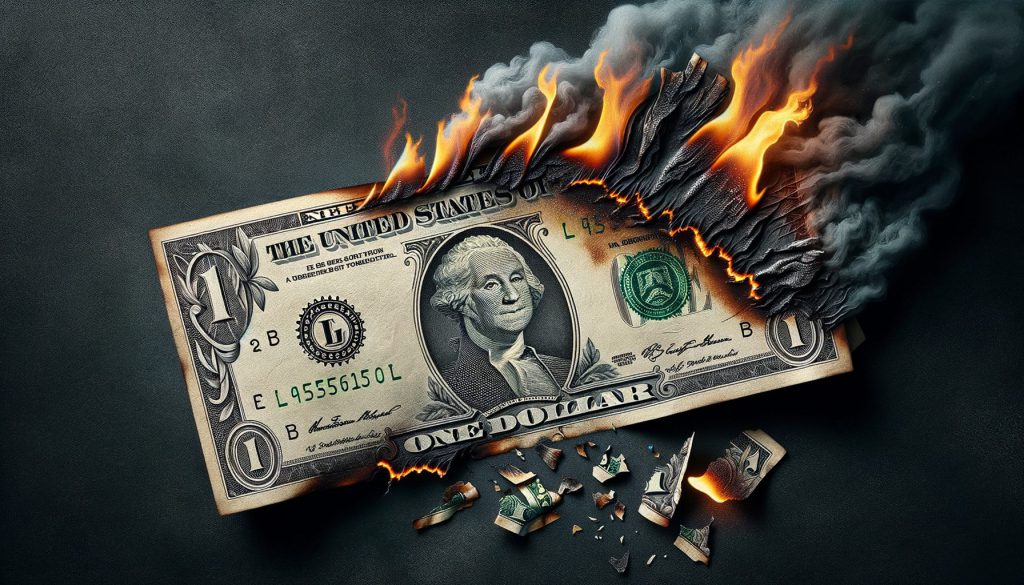US Dollar To Fall In Orderly Way, Says Nomura’s Richard Koo

The US dollar to fall is being predicted by Nomura’s chief economist Richard Koo, and he expects an orderly decline rather than a sudden collapse. Rising treasury yields, new steel tariffs, and mounting US debt are creating conditions for controlled dollar weakness. His analysis suggests manufacturing data showing continued contraction, combined with trade policy shifts, will drive this currency adjustment.
Also Read: De-Dollarization Changes Trade Rules: 40+ Countries Ditch US Dollar
Debt, Yields And Tariffs Signal Controlled US Dollar Weakness

Manufacturing Data Confirms Dollar Weakness
The ISM manufacturing index dropped to 48.5 in May, and this marks continued sector contraction that’s fueling concerns about the US dollar to fall scenario. This manufacturing data represents more than just economic weakness – it signals underlying structural issues that currency markets are beginning to price in at the time of writing.
Treasury yields climbed to 4.97% on the 30-year bond as demand softened, creating an unusual situation where higher yields aren’t supporting dollar strength. Treasury Secretary Scott Bessent moved quickly to address market concerns about US debt sustainability, and also to reassure investors.
Richard Koo said regarding historical patterns:
“I think we should get hints from Trump’s first term on the dollar. At the very beginning when he was elected there was another Trump deal eight years ago and the dollar went up.”
Steel tariffs announced at 50% on imports have already triggered aluminum premiums to surge 54% and steel futures to rise 14%. These trade measures are reshaping market expectations about the US dollar to fall trajectory, and also creating inflationary pressures.
Central Bank Policies Miss Currency Targets
Koo’s analysis reveals why traditional forecasting fails when predicting whether the US dollar to fall will materialize. His research shows that central bank policies often produce opposite results from what economists expect, and also demonstrates the complexity of currency markets.
Richard Koo stated this about policy effectiveness:
“Well their forecast on policy all turn out to be correct. Bank of Japan did nothing. ECB did nothing. US Federal Reserve raised interest rates eight times. But the dollar kept on going down and down and down. So those forecasters are completely wrong.”
This observation highlights how treasury yields and interest rate policies don’t always translate into currency strength. Manufacturing data continues to show weakness despite higher rates, suggesting the Federal Reserve’s tools have limited impact on economic fundamentals right now.
The steel tariffs represent an attempt to address trade imbalances, but they’re also creating inflationary pressures that could accelerate the US dollar to fall scenario. Current US debt levels make traditional monetary policy less effective at supporting currency stability, and also complicate the Federal Reserve’s decision-making process.
Trade Deficits Drive Currency Psychology
The relationship between trade policy and currency markets goes beyond simple supply and demand. Koo explained how presidential rhetoric about trade deficits creates market psychology that influences the US dollar to fall expectation, and also affects investor sentiment.
Richard Koo explained this market dynamic:
“And when the US president talks about trade deficit and then people look at trade deficit it’s a huge red. Which means if no one else is buying only exporters and importers are buying dollars the dollar should be depreciating.”
This insight shows how steel tariffs and trade policies create psychological pressure on currency markets. Manufacturing data supports this view, with production declining across multiple sectors as trade tensions escalate, and also as global supply chains adjust.
Treasury yields continue rising as investors demand higher compensation for holding US debt, but this isn’t translating into dollar strength at the time of writing. The combination of weak manufacturing data and aggressive trade policies is creating conditions for the US dollar to fall scenario that Koo predicts.
Richard Koo had this to say about government intervention:
“So I don’t think a US government would be deliberately talking down the dollar until maybe some sort of an agreement is reached among G7 plus China perhaps.”
Also Read: Could This Asset Outperform Bitcoin, Gold, & the Dollar?
This suggests any significant acceleration in the US dollar to fall trend would require international coordination. Current steel tariffs and rising treasury yields are creating market pressures, but Koo expects an orderly decline rather than crisis-driven weakness. Manufacturing data and US debt concerns support this controlled adjustment scenario, and also indicate that policymakers have time to manage the transition.
Read More

Solana Could Drop Block Limits as Firedancer Challenges Compute Unit Cap
US Dollar To Fall In Orderly Way, Says Nomura’s Richard Koo

The US dollar to fall is being predicted by Nomura’s chief economist Richard Koo, and he expects an orderly decline rather than a sudden collapse. Rising treasury yields, new steel tariffs, and mounting US debt are creating conditions for controlled dollar weakness. His analysis suggests manufacturing data showing continued contraction, combined with trade policy shifts, will drive this currency adjustment.
Also Read: De-Dollarization Changes Trade Rules: 40+ Countries Ditch US Dollar
Debt, Yields And Tariffs Signal Controlled US Dollar Weakness

Manufacturing Data Confirms Dollar Weakness
The ISM manufacturing index dropped to 48.5 in May, and this marks continued sector contraction that’s fueling concerns about the US dollar to fall scenario. This manufacturing data represents more than just economic weakness – it signals underlying structural issues that currency markets are beginning to price in at the time of writing.
Treasury yields climbed to 4.97% on the 30-year bond as demand softened, creating an unusual situation where higher yields aren’t supporting dollar strength. Treasury Secretary Scott Bessent moved quickly to address market concerns about US debt sustainability, and also to reassure investors.
Richard Koo said regarding historical patterns:
“I think we should get hints from Trump’s first term on the dollar. At the very beginning when he was elected there was another Trump deal eight years ago and the dollar went up.”
Steel tariffs announced at 50% on imports have already triggered aluminum premiums to surge 54% and steel futures to rise 14%. These trade measures are reshaping market expectations about the US dollar to fall trajectory, and also creating inflationary pressures.
Central Bank Policies Miss Currency Targets
Koo’s analysis reveals why traditional forecasting fails when predicting whether the US dollar to fall will materialize. His research shows that central bank policies often produce opposite results from what economists expect, and also demonstrates the complexity of currency markets.
Richard Koo stated this about policy effectiveness:
“Well their forecast on policy all turn out to be correct. Bank of Japan did nothing. ECB did nothing. US Federal Reserve raised interest rates eight times. But the dollar kept on going down and down and down. So those forecasters are completely wrong.”
This observation highlights how treasury yields and interest rate policies don’t always translate into currency strength. Manufacturing data continues to show weakness despite higher rates, suggesting the Federal Reserve’s tools have limited impact on economic fundamentals right now.
The steel tariffs represent an attempt to address trade imbalances, but they’re also creating inflationary pressures that could accelerate the US dollar to fall scenario. Current US debt levels make traditional monetary policy less effective at supporting currency stability, and also complicate the Federal Reserve’s decision-making process.
Trade Deficits Drive Currency Psychology
The relationship between trade policy and currency markets goes beyond simple supply and demand. Koo explained how presidential rhetoric about trade deficits creates market psychology that influences the US dollar to fall expectation, and also affects investor sentiment.
Richard Koo explained this market dynamic:
“And when the US president talks about trade deficit and then people look at trade deficit it’s a huge red. Which means if no one else is buying only exporters and importers are buying dollars the dollar should be depreciating.”
This insight shows how steel tariffs and trade policies create psychological pressure on currency markets. Manufacturing data supports this view, with production declining across multiple sectors as trade tensions escalate, and also as global supply chains adjust.
Treasury yields continue rising as investors demand higher compensation for holding US debt, but this isn’t translating into dollar strength at the time of writing. The combination of weak manufacturing data and aggressive trade policies is creating conditions for the US dollar to fall scenario that Koo predicts.
Richard Koo had this to say about government intervention:
“So I don’t think a US government would be deliberately talking down the dollar until maybe some sort of an agreement is reached among G7 plus China perhaps.”
Also Read: Could This Asset Outperform Bitcoin, Gold, & the Dollar?
This suggests any significant acceleration in the US dollar to fall trend would require international coordination. Current steel tariffs and rising treasury yields are creating market pressures, but Koo expects an orderly decline rather than crisis-driven weakness. Manufacturing data and US debt concerns support this controlled adjustment scenario, and also indicate that policymakers have time to manage the transition.
Read More

